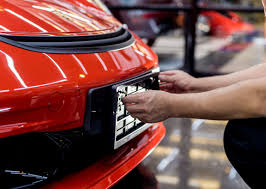Table of Contents
- Introduction to Private Number Plates
- Understanding the Value of Private Number Plates
- Types of Private Number Plates
- The Legal Framework Surrounding Private Number Plates
- How to Choose the Right Private Number Plate
- Where to Buy Private Number Plates
- The Process of Purchasing a Private Number Plate
- Registration and Transfer Process
- Maintenance and Display Regulations
- Investing in Private Number Plates
Introduction to Private Number Plates
Private number plates have become increasingly popular as a way for vehicle owners to express their individuality or make a statement about their identity. Unlike standard registration plates issued by the government, private number plates can be personalised or feature unique combinations of letters and numbers that hold personal significance for the owner. This trend has gained traction in various demographics, from car enthusiasts to business owners seeking to promote their brand.
Understanding the Value of Private Number Plates
The value of private number plates can vary significantly based on several factors including rarity, desirability, and market demand. Some plates can be acquired for a few hundred pounds, while others may command prices in the thousands or even tens of thousands. The allure often lies in the potential for appreciation over time, making them not just a personal asset but also an investment opportunity.
Statistics show that certain categories of private plates, such as those featuring initials or names, consistently attract higher values than generic ones. For instance, plates with popular names or high-profile initials often see bidding wars at auctions, underscoring their perceived value among buyers.
Types of Private Number Plates
Private number plates can generally be classified into several categories:
- Personalised Plates: These are designed to reflect an individual’s name or initials.
- Dateless Plates: These do not indicate a specific year of registration and can be applied to vehicles of any age.
- Suffix and Prefix Plates: These include letters that denote the year of registration, making them more easily identifiable.
- New Style Plates: Introduced in 2001 in the UK, these follow a specific format that includes two letters, two digits, and three letters.
Each type has its unique appeal and market demand, influencing both their acquisition process and resale value.
The Legal Framework Surrounding Private Number Plates
Understanding the legalities surrounding private number plates is crucial before making a purchase. In most jurisdictions, including the UK, private number plates must adhere to specific regulations set forth by vehicle licensing authorities.
These regulations cover aspects such as:
- Legitimacy: The plate must not be deemed offensive or misleading.
- Ownership Rights: Proper documentation must prove ownership before a plate can be transferred or sold.
- Display Rules: There are strict guidelines regarding how and where private plates should be displayed on vehicles.
Failing to comply with these regulations can result in fines or penalties, making it essential to familiarize oneself with local laws governing private number plates.
How to Choose the Right Private Number Plate
Choosing the right private number plate involves careful consideration of personal preferences and potential future value. Here are key factors to keep in mind:
- Personal Connection: Opt for combinations that resonate personally—whether through initials, significant dates, or memorable phrases.
- Market Trends: Be aware of current trends within the private plate market; certain themes may become popular over time.
- Investment Potential: Consider how well a plate may appreciate in value over time; dateless and personalised plates often hold more value.
Engaging with experts from reputable agencies like Top Reg can provide insights into trending options and market predictions.
Where to Buy Private Number Plates
There are several avenues through which one can purchase private number plates:
- Online Marketplaces: Websites dedicated to listing private number plates provide extensive options for buyers.
- Auction Houses: High-end auctions often feature rare and valuable private plates that might not be available elsewhere.
- Specialist Dealers: Companies like Top Reg specialize in selling personalised number platesand can offer expert advice on selections tailored to individual tastes.
Researching multiple sources allows buyers to compare prices and find the best deals available.
The Process of Purchasing a Private Number Plate
The process for acquiring a private number plate typically follows these steps:
- Identifying Your Desired Plate: Use online tools or consult with dealers like Top Reg to find available options.
- Checking Availability: Ensure that your desired plate is not already registered under someone else’s name.
- Making Payment: Once you decide on a plate, you will need to pay for it through your chosen platform.
- Receiving Documentation: After payment is confirmed, you will receive necessary documents proving ownership.
Following these steps diligently ensures a smooth purchasing experience without complications.
Registration and Transfer Process
Once you have acquired your private number plate, registering it correctly is vital for legal compliance:
- Notify DVLA (or equivalent authority): Inform your local vehicle licensing authority about your new acquisition.
- Complete Required Forms: Fill out any necessary paperwork provided by the licensing authority.
- Attach New Plates: Once registration is complete, ensure that your new number plates are affixed correctly on your vehicle.
This step is critical; failure to register your new plate can lead to legal issues down the line.
Maintenance and Display Regulations
After securing your private number plate, understanding how to maintain compliance with display regulations is essential:
- Visibility Requirements: Ensure that your plate remains visible under all lighting conditions.
- Regular Inspections: Periodically check for wear and tear; replace damaged plates promptly.
- Adherence to Local Laws: Keep up-to-date with any changes in regulations regarding display standards.
Maintaining proper standards not only keeps you compliant but also protects the investment you’ve made in your private number plate.
Investing in Private Number Plates
Investing in private number plates has become an attractive venture for many individuals looking for alternative assets:
- Market Dynamics: As popularity grows, certain types of plates have shown consistent appreciation rates.
- Diversification Strategy: Adding private number plates to an investment portfolio can provide diversification benefits as they typically respond differently than traditional investments.
- Seek Expert Guidance: Engaging with industry professionals like Top Reg can help investors make informed choices based on market trends and historical data.
In conclusion, acquiring a private number plate involves more than merely selecting a unique combination of letters and numbers; it encompasses understanding market dynamics, legal requirements, and maintenance regulations while considering personal preferences and investment potential. As this niche continues to grow in popularity, staying informed will enable prospective buyers to navigate this fascinating arena successfully while ensuring compliance with all necessary regulations and maximizing investment opportunities along the way.
By following these guidelines and leveraging expert resources such as Top Reg throughout the process, individuals can enhance their experience in acquiring a unique piece of automotive identity that resonates personally while potentially serving as a valuable investment asset in the long run.



































